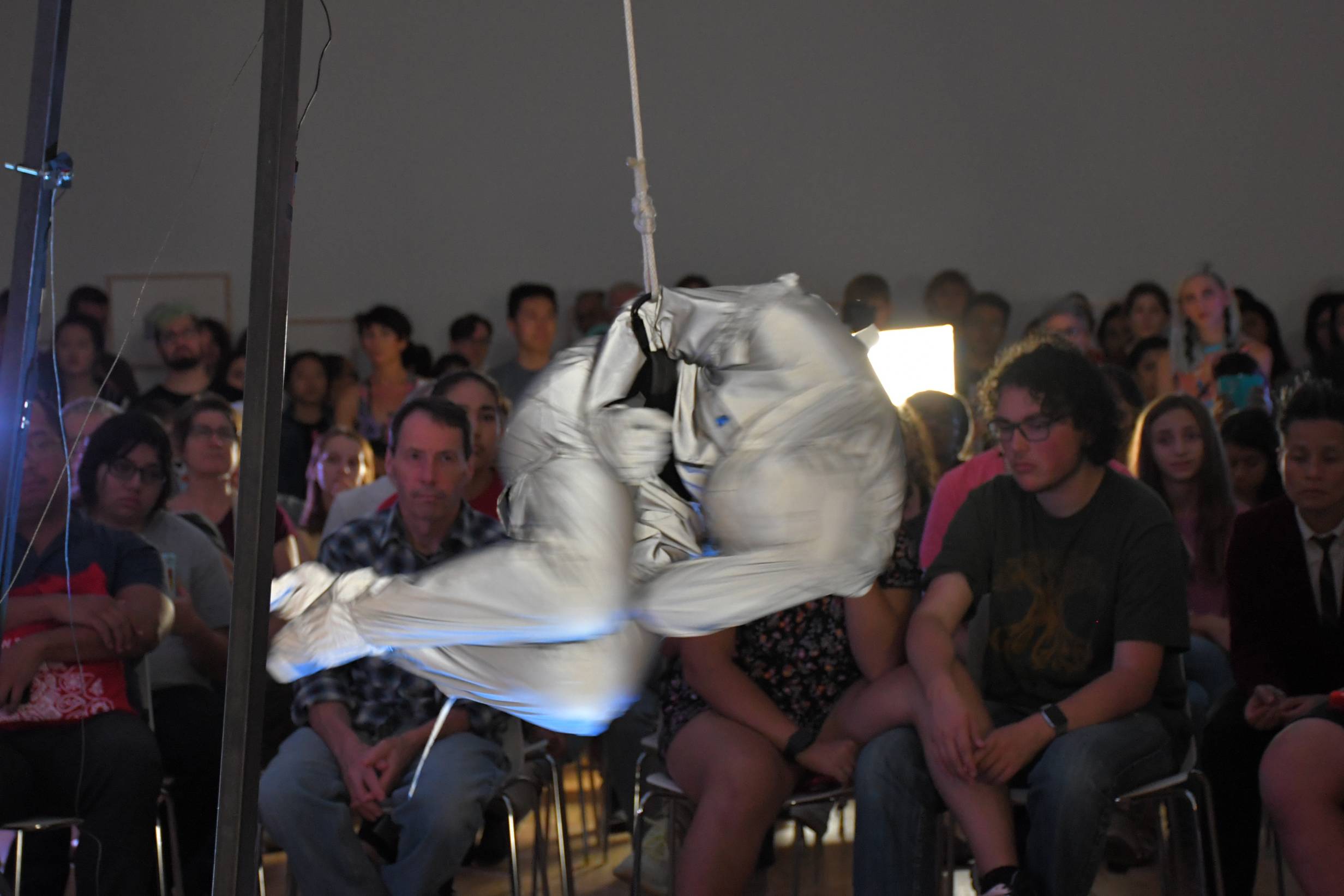Miami-born Erica Gressman is a queer, Latinx and Colombian avant-garde performance and sound artist, costume designer, and design engineer currently living and working in Chicago. Her work is influenced by noise music, performance and video art, the punk aesthetic, queer camp and kitsch culture, Latinx social spaces, religious iconographies, intercultural theater, science, and science fiction. She is interested in the post-human for aesthetic, personal, and political reasons. In the simplest terms, post-human refers to what it means to be beyond human, to be able to inhabit and exist in multiple identities.
Gressman’s exhibition, Limbs, Ligaments, Parts: My Body is There, is on view at La Estación Gallery located at the Latina/Latino Studies building. Curated by Sandra Ruiz, assistant professor of Latina/Latino Studies and English, with Amy L. Powell, curator of Modern and Contemporary Art at Krannert Art Museum, Gressman performed her piece, Limbs, at the KAM a few weeks ago. The performance was vulnerable, emotionally driven, and visceral. The following day Gressman gave an artist talk titled, “Art Under Trumpism: A Queer Latinx Journey”.
Gressman’s live performance, Limbs, involves a metal cage doubling as a large-scale sound instrument. Violin-like electronic sounds were controlled by Gressman’s body moving within the cage and through the removal of limbs, ligaments, body parts, and multiple-heads. The instruments were responsive to movement and light using contact mics and light receptors. Her movement is responsive to the sound and the light is responsive to her movement. In this way, it is a feedback loop, a process she calls “biofeedback.”
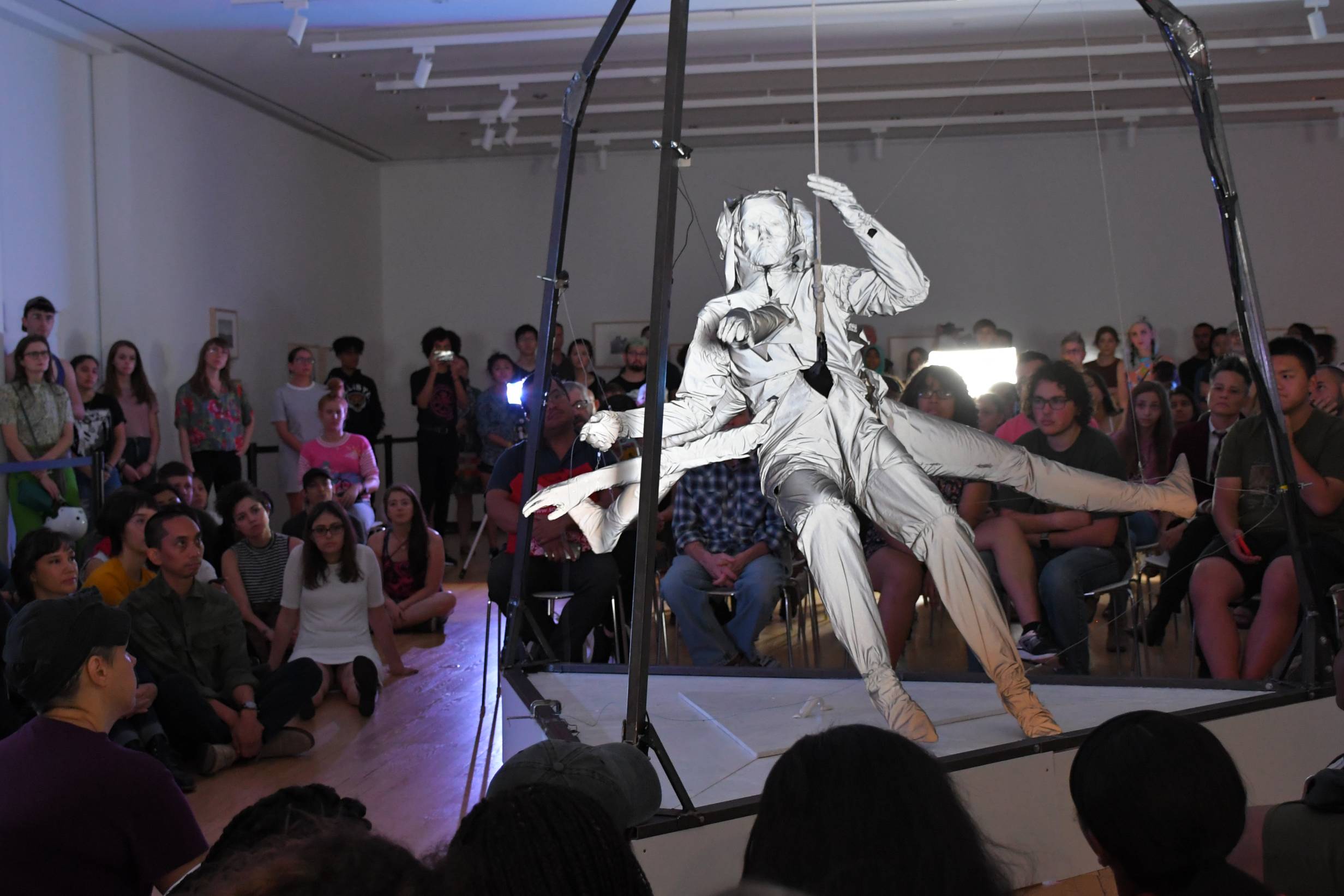
In the performance, Gressman is wearing a suit made of a highly reflective material that glows brightest if there is a light behind you shining onto the costume at eye level. “I wanted the figure to look like a bioluminescent alien aquatic multi limb creature that was underwater or in space,” she told me. For Gressman, the highly reflective costume is a metaphor for reflection. What happens when we stop reflecting? “This piece is about loved ones and how they relate to the self and what happens if we lose that. How does it reflect back to me/my identity? Do I lose that part of my identity if I lose that side of my family? Who am I at that point?”
Extra arms and legs were attached to the suit, which made Gressman look like a spider-like creature or, as one audience member described, a goddess. Gressman’s face was covered in a mask with three faces on it. She was covered head-to-toe in the glowing white costume and beneath that, she was completely covered in solid black zentai. Her face and all surfaces of her body were completely covered through the entire performance.
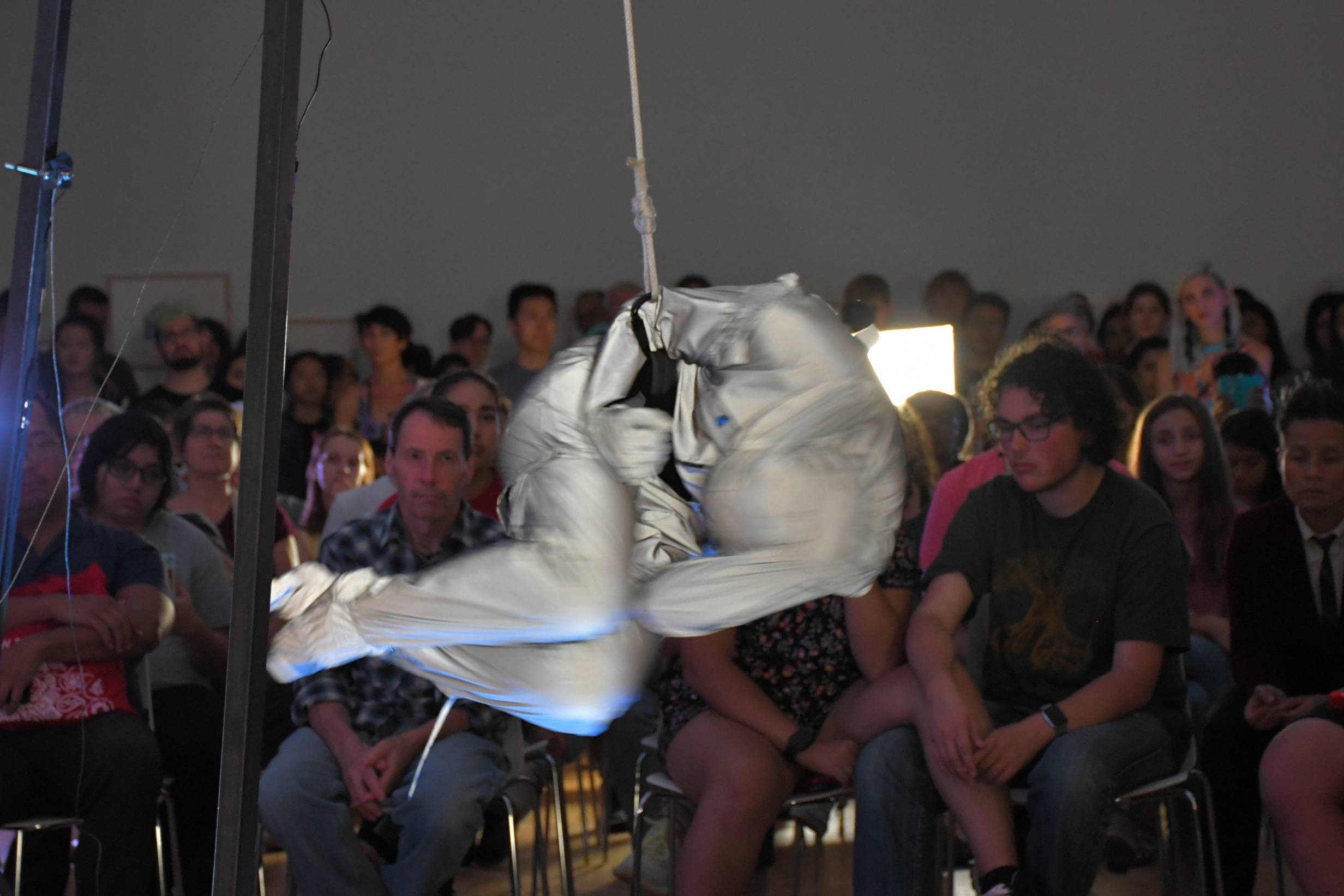
Gressman was suspended in the cage by a rope. She thrashed in the cage. At one point she threw herself so hard that she hit the edge of the cage. Over the sounds of electronic noise and violins, we heard her body hit the steal hard. It felt violent and precarious to watch, this struggle against the cage which was suspending her and containing her.
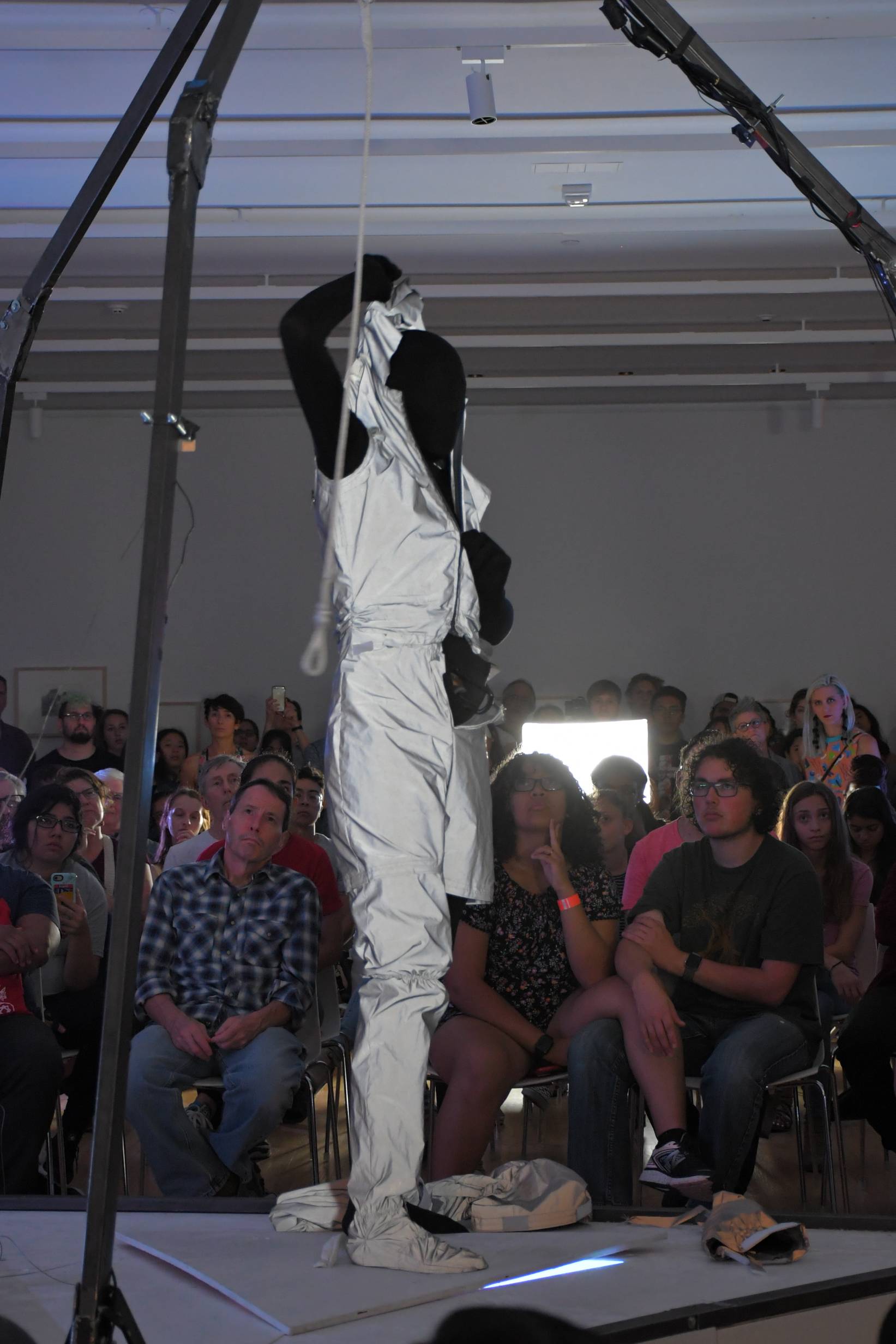
Throughout the performance Gressman removed limbs from her body. Sometimes they popped off as they were attached by buttons. At other times I could hear her costume tearing as she ripped them off, dismembering herself. The removal of limbs was layered in meaning: losing a part of the self, detaching from perspectives that are no longer needed or are toxic, as well as for the forced separation of families. As the performance continued, she tore off the white glowing costume, revealing her body in the solid black zentai as if she were disappearing.
I was curious about what being veiled and veiling her senses as a performer does to her movement, her sense of self, her experience performing. She said,
Being veiled and desensitized is a metaphor for this work. I see all of us growing in this world with very limited perspectives. A lot of those perspectives are influenced by or our loved ones or family. As they part from our lives perhaps our perspective does as well. I also wanted a feeling of claustrophobia as I performed the piece. A lot of the perspectives I learned were harming and limiting to my growth and I had to disattach from those that imposed it on me.
The following day, Gressman gave a lecture called “Art Under Trumpism: A Queer Latinx Journey.” She talked about the power that the collectivity of protesting, going to parties, and performing/going to performance has in a community and the development of a community that is moving and bringing about social change. She wants her performances to create an ecstasy among the audience and performers, an experience that we are in harmony because we are feeling the same things collectively, potentially generating a personal and collective resilience.
She says that she makes what she does to feel something, to listen to the feelings. Gressman believes that art should make an audience feel something. “We need to keep feeling, to feel this urgency and intensity, to feel what we are told not to feel and to ignore.” She wants to put identity at the forefront of the performance because identity is something that she says can be taken away, we can lose ourselves, and she wants to engage with the fear of having her identity taken away from her.
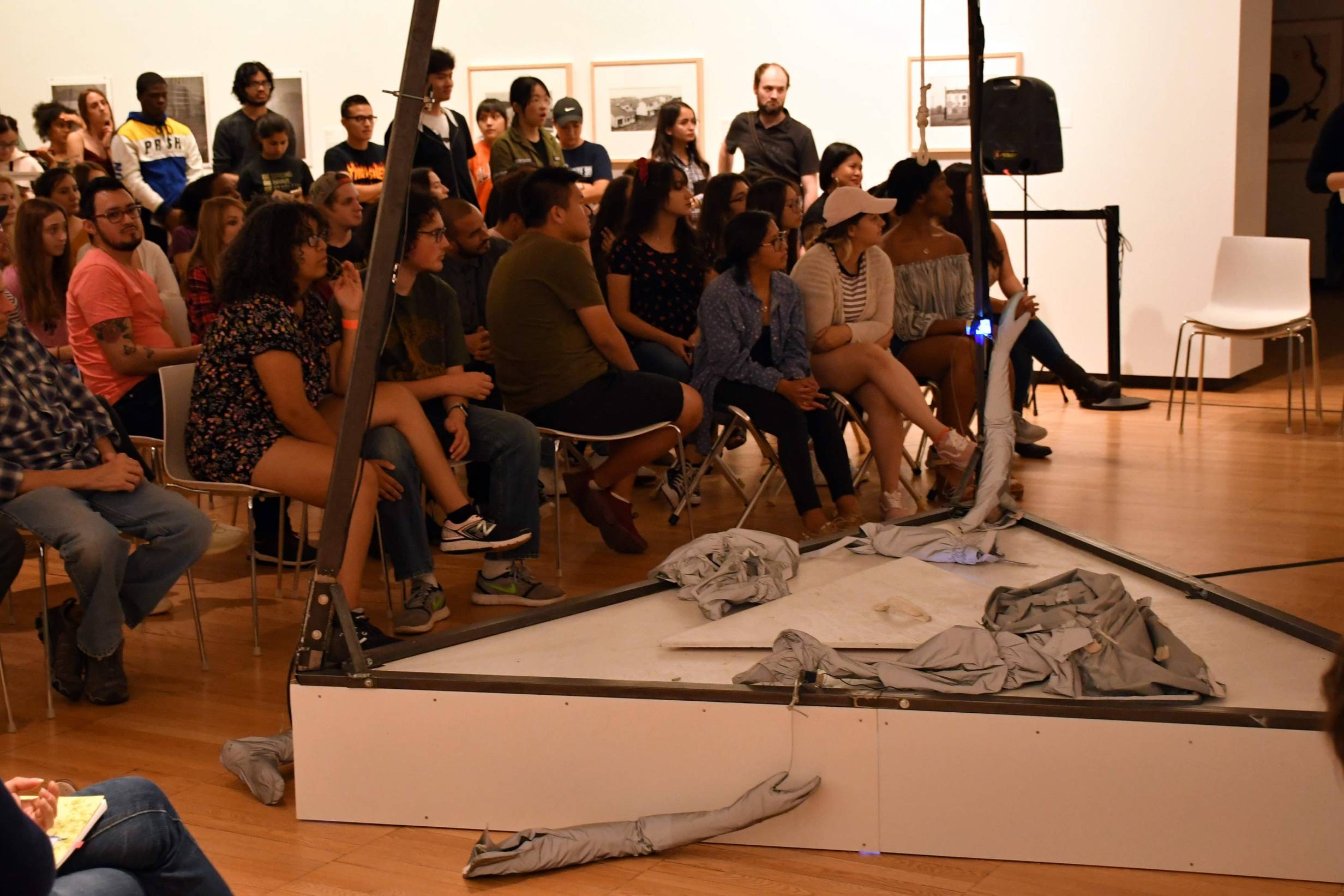
Gressman’s performances explore post-human possibilities beyond suffocating binaries. She is a queer Latinx artist who is making art and surviving in these times, discussing how she is surviving. Limbs is a response to feeling disembodied, dislocated. Gressman felt a responsibility to deal with deep emotion by creating a piece that abstracted what couldn’t be put into words, to hang on to a feeling of loss and mourning. She was suspended by a rope in the performance as a metaphor for the feeling of hanging on by a thread. She can’t ignore the vulnerability of who she is. “Who you are can be taken away and lost unless we amplify who we are for democracy.” She is asking how she can make art on a scale that means something to her. “People came [to the performance] to feel with me. That’s what I needed.”
During the lecture she said that “Fascist regimes use our work against us.” She spoke about the importance of creating a community on a vast network to fight fascism. We need to constantly find new ways to reinvent what creativity and community means. Gressman’s performance gives hope to be who we are. “The body in motion is radical protest. The body expressing and being yourself in your own body is a form of protest and performance art has that gravity. It’s time to see what the body can do in space. What you do with the self can be radical and bring your awareness to feelings you didn’t know were there,” she said. 300 people attended Gressman’s performance at KAM. Her work reached a large community, touching many who experienced her work.
Art can play a role in envisioning the future. Art builds community, kinship, and asserts that life has value. Gressman’s work is layered with metaphors and meanings. The plurality of meaning mirrors a plurality of self and perspective in the performance, a self who is more than one thing, who is entangled in layers of experience as she entangles the audience in layers of sensory engagement. To me, it’s about how we engage with and experience our bodies, our senses, and the world around us, all of us who are in it. We are invited to listen, feel, and see, differently in layers.
Limbs, Ligaments, Parts: My Body is There
La Estación Gallery
1207 W Oregon St
Urbana
Through April 1st
Photos courtesy of Alicia Rodriguez








